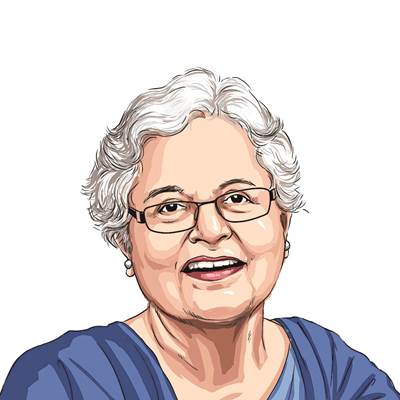Opinion A David versus Goliath battle is set for 2024
Coomi Kapoor writes: The opposition has to take on a behemoth well-entrenched in government, bureaucracy, politics and the media
 The BJP’s bigger asset is, of course, Narendra Modi. His appeal cuts across caste, income levels and all social strata. (Express Photo: Nirmal Harindran)
The BJP’s bigger asset is, of course, Narendra Modi. His appeal cuts across caste, income levels and all social strata. (Express Photo: Nirmal Harindran) There is a pall of gloom over those who are not fans of Prime Minister Narendra Modi after his confident claim that the 2022 results would determine the fate of the 2024 Lok Sabha polls, and they are a reflection of the country’s thinking for the next 25 years. It is not just political parties who are concerned, but also those who believe that a robust opposition is the only way to stave off the hegemony of an autocratic, single-party rule in a democratic polity. Modi’s electoral machinery has once again shattered conventional assumptions in Indian politics. In the post-Mandal era, caste identity is not necessarily the defining factor in voter preference. In bipolar contests, voter swings are not always determined by anti-incumbency. Assumptions that the government would pay the price for its blunders of the last two years, including its handling of the Covid-19 pandemic, dogmatically taking on the powerful farmer lobby and the economic slowdown, were all proved incorrect.
The fight between the ruling establishment and its opponents appears to be a David versus Goliath contest. The opposition has to take on a behemoth well-entrenched in government, bureaucracy, politics and the media. Its cadre based, 24X7 electoral machine takes full advantage of the latest technology in sample surveys and communications. The BJP’s carefully thought-out social engineering has created an inclusive umbrella in which even disparate castes from non-Yadav OBCs, SCs, once considered die-hard Mayawati loyalists, and Jats, angered by the government’s farm laws, have come together. The conspicuous absentees are the Muslims. Its opponents argue that battling the Modi juggernaut is like playing with a loaded dice: Whenever the chips are down, the BJP attempts to polarise society on communal lines. But the Hindutva card cannot explain success in states like Goa, Uttarakhand and Manipur and, in this campaign, even Yogi emphasised his development work more than Hindutva, though he did make some overtly communal remarks.
The BJP’s bigger asset is, of course, Narendra Modi. His appeal cuts across caste, income levels and all social strata. Modi gets the credit for the social welfare measures at the grassroots, whether gas cylinders, toilets or free rations. These schemes are noteworthy for their remarkably effective, unbiased delivery system reliant on an impersonal computerised list. The difference in Modi’s welfare measures from the past is that the beneficiaries were earlier dependent on corrupt intermediaries, a reality which even Rajiv Gandhi as Prime Minister once ruefully acknowledged. While Modi deserves the maximum credit for the UP win, Yogi Adityanath’s contribution as a hands-on CM who maintained law and order in the state, even if the police resort at times to high-handed methods cannot be ignored.
Ironically, one of the biggest contributors to the BJP’s victories was the opposition. In Goa, for instance, it was not just new entrants such as the AAP and TMC that whittled down the Congress vote share; even the infant Revolutionary Goans Party played a part in depriving the Congress of victory in constituencies that were earlier considered safe in south Goa. The BJP won several seats by narrow margins. The BJP’s vote percentage in the state in 2022 is 33.31, a mere one per cent more than 2017, when it decisively lost the elections, capturing only 13 out of 40 seats. This time, with practically the same vote share, it was victorious in 20 seats.
The index of opposition unity, which our pollsters are fond of expounding upon, was actually higher in Uttar Pradesh. It was not that there were fewer opposition parties in UP but the SP effectively grabbed the main opposition space at the expense of others. This explains why although the BJP vote share this time, at 41 per cent, was nearly 2 per cent higher than 2017, its seat tally came down by 57. The SP, which won 111 seats, had an impressive 32 per cent vote share. The BSP got only 13 per cent of the votes, down from around 22.2 per cent in 2017. The grand old party, despite Priyanka Gandhi Vadra’s feisty antics, got a mere 2.3 per cent, down from 6.2 per cent last time. And yet the Congress had made it a prestige issue that it would contest alone and not in an alliance with the rest of the opposition.
As the Congress party disintegrates, since the entitled Gandhi family refuses to read the writing on the wall, the number of contenders for the opposition space has grown. The Gandhis, however, cocooned in their ivory tower, remain serenely convinced that they are the fulcrum for the rest of the opposition and the only moral bulwark against the communal BJP. The Gandhi siblings refuse to step down from their lead roles in their party, though they lurch from one blunder to the next — Punjab and Uttarakhand being the most recent examples, where defeat was wrested from the jaws of victory by whimsical, rash and ill-conceived decisions. With AAP’s convincing victory in Punjab, there is one more contender for the beleaguered Congress’s place. The advantage of the newbie is that it is led by a fresh face in his early fifties in a field crowded with those who are either founders or inheritors of political dynasties. Arvind Kejriwal is a face which north India, where the bulk of the country’s votes are from, can relate to — unlike most regional leaders.
In politics, it is always premature to make long-term projections. From my years in political journalism, I have learnt one lesson: Things seldom remain static and situations can change overnight. Remember the sudden transformation of the public mood during Manmohan Singh’s tenure when Anna Hazare launched his movement. Even the mighty Indira Gandhi, who we once assumed was invincible, tripped up in the 1977 general elections. She never believed that the rag-tag squabbling opposition leaders would ever join hands. The then opposition sacrificed individual egos and ambitions, because in the draconian days of the Emergency, they realised that if they did not all act together, they would be decimated individually. The future of India’s polity in the next quarter of a century depends not on the ruling party alone but on the opposition as well.
This column first appeared in the print edition on March 15, 2022 under the title ‘Victory & health warning’. The writer is consulting editor, The Indian Express







